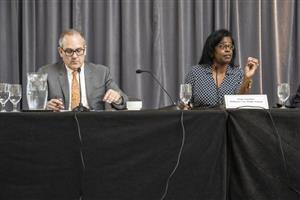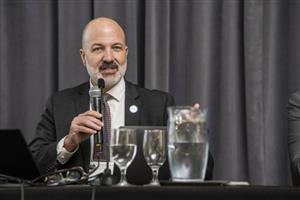- Council of the Great City Schools
- How Three Urban School Districts are Investing and Tracking ESSER Funds
Urban Educator - April 2023
Page Navigation
- Education Secretary Cardona: School Leaders, Be Changemakers
- Fighting for Student Reading Success
- Journalist Says Urban School Leaders in the Forefront of Change
- Kansas City Names New Superintendent
- How Three Urban School Districts are Investing and Tracking ESSER Funds
- Linguist Lily Wong Fillmore Named Recipient of Dr. Michael Casserly Legacy Award
- Urban Schools Win Green Ribbon Awards
How Three Urban School Districts are Investing and Tracking ESSER Funds
-
At the Council of the Great City Schools’ recent Annual/Legislative Policy Conference, urban educators heard from superintendents of three school districts on how they are using Elementary and Secondary School Emergency Relief (ESSER) funding to meet the needs of their districts.
Sonja Santelises, CEO of Baltimore City Public Schools, said the district received approximately $690 million in federal funding. “A lion’s share of a good amount of the district’s investments was on programming and supports around learning loss, as well as summer programming, extended learning, and credit recovery,” Santelises said. “And this really was driven from our belief that we needed more time for our young people to be able to engage in the kinds of enriching experiences that we knew were going to get them back connected to school.”

One of the programs funded through ESSER is Saturday school, now in its second year, which gives nearly 800 students the opportunity to catch up on credits and access the learning necessary to reach their goals of graduation and beyond. The half-day program runs for 14 Saturdays a year and offers a wide variety of coursework, such as math, English, social studies, science, health, physical education, music, art, computer science, CTE-pathways and foreign languages. In addition to academic classes, students receive services such as mentoring, social worker counseling, special education instruction, and free meals.
Federal funds are also being used to improve the district’s infrastructure and make repairs and renovations to old school buildings, an issue that is very important to parents and the community.
“In Baltimore, city facilities matter,” said Santelises. “It’s important for the community to be able to see the spaces that children are learning in have been positively impacted by these dollars.”
Building Transparency in Clark County
Clark County School District in Las Vegas made a concerted effort to involve parents and the community in the district’s plan to spend $777 million in federal funds. Town halls were held, surveys were conducted, and input was gathered from 13,000 community stakeholders.
District officials and the school board worked to invest funds in alignment with the strategic priorities in the district’s five-year strategic plan. Investments made by the school system include providing a laptop or tablet to give every student access to a variety of online curricula, as well as one-on-one tutoring and mental health services. Every elementary school was provided an ESSER budget to address individual student needs regarding academic, social-emotional and behavioral support.
In an effort to provide transparency, the district used ESSER funds to create an online data dashboard that includes key measures of student performance at each school. The dashboard allows parents and the community to track -- through the district’s website -- enrollment, attendance data, state test scores, behavior, and other performance measures.
“It’s public so it allows the community to see exactly what is happening in our schools,” said Clark County Schools Superintendent Jesus Jara.
The district has a chief strategy officer who meets with community stakeholders and parents and provides updates and reports to state and federal legislators on the impact federal funds are having on the school district.
“We are always asking ourselves how we can continue to monitor [spending], as an organization, and update the public and make sure that we’re spending it appropriately,” said Jara.
Demonstrating Results in St. Paul
When Rep. Bobby Scott (D-Va.) appeared at the Council’s virtual Legislative/Policy Conference in 2021 he told urban school educators to use the ARP money they received wisely, remarks that appeared in a U.S. News & World Report article.
St. Paul Schools Superintendent Joe Gothard recalled he made copies of the article and sent it to school board members and his leadership team. “It’s served, and continues to serve, as a real motivation and real charge for me and our community to make sure that we do right for kids and for our community with this funding,” said Gothard.
St. Paul Public Schools received approximately $207 million in federal funding, and Gothard created an Innovation Office to review data and feedback, as well as track the effectiveness of 56 strategic initiatives being funded by ARP. “I wanted a separate body to really look at this and give me very strategic input in terms of decisions that I was going to make,” said Gothard.

The WINN (What I Need Now) Reading program was launched during the 2021-2022 school year to provide support and intensive literacy instruction for struggling readers. The Minnesota Department of Education provided 180 hours of methods training in the “science of reading.” According to district officials, students in the program saw positive growth in their reading scores on average, with students in the second and third grades achieving higher growth scores than their peers.
The nation’s school districts must spend or commit the one-time federal funds they received by the end of September 2024. “It’s incredibly important that we spend the funds, but I also want to spend it well, and make sure that it’s being spent on proven strategies,” said Gothard.
Media Contact:
Contact Name
Contact@email.com
(000) 000-0000
Contact Name
Contact@email.com
(000) 000-0000
Contact Name
Contact@email.com
(000) 000-0000
Media Contact:
Contact Name
Contact@email.com
(000) 000-0000
Contact Name
Contact@email.com
(000) 000-0000
Contact Name
Contact@email.com
(000) 000-0000


